|
|
| Пишет nargizzza ( @ 2009-03-26 16:39:00 |
|
|
|
|
|
|
|
|
|
|
|
|
|
|
Driver License - Laws and Rules of the Road
Respecting the right-of-way of others is not limited to situations such as yielding to pedestrians in crosswalks, or watching carefully to ensure the right-of-way of bicyclists and motorcyclists. Motorists must respect the right-of-way of others, by not violating traffic laws such as failing to top at a stop sign or traffic light, speeding, making unsafe lane changes, or illegal turns. Statistics show that a high percentage of injury accidents in California are caused by right-of-way violations.
A pedestrian is a person on foot or who uses a conveyance such as roller skates, skateboards, etc., other than a bicycle. A pedestrian can also be a person with a disability on a tricycle or quadricycle or in a wheelchair.
Pedestrians have the right-of-way in crosswalks, even if the crosswalk is in the middle of the block.
A crosswalk is that part of the roadway where the sidewalk lines would extend across the street, and it is set aside for pedestrian traffic.
Crosswalks are often marked with white lines. Yellow crosswalk lines may be painted at school crossings. Most often, crosswalks in residential areas are not marked.
An intersection is any place where one line of traffic meets another. Intersections include cross streets, side streets, alleys, freeway entrances, and any other location where vehicles traveling on different highways or roads join each other.
Safety suggestion:
While waiting to turn left, keep your wheels pointed straight ahead until it is safe to start your turn. If your wheels are pointed to the left, and a vehicle hits you from behind, you could be pushed into oncoming traffic.
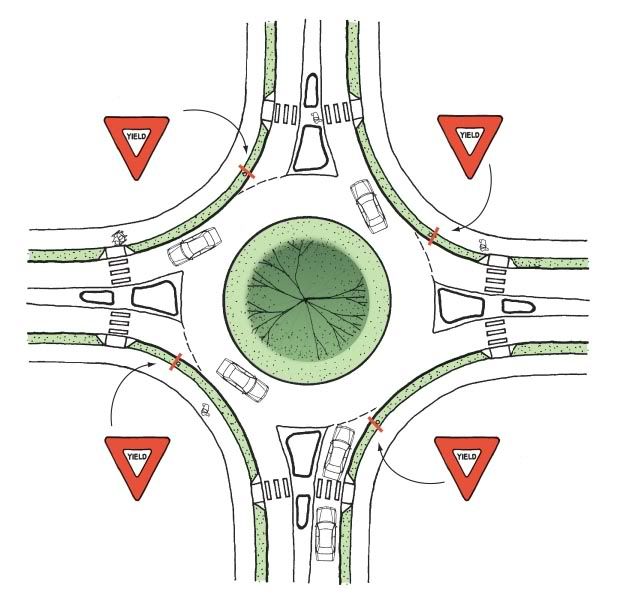
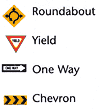
A roundabout is an intersection where traffic travels around a central island in a counter-clockwise direction. Vehicles entering or exiting the roundabout must yield to vehicles, bicyclists, and pedestrians.
As you approach the entry to the roundabout, there will be a "Yield" sign and dashed yield line at the roundabout intersection. Slow down, watch for pedestrians and bicyclists and be prepared to stop if necessary. When you enter, yield to circulating traffic from the left, but do not stop if it is clear. The roundabout will have "One Way" and Chevron signs mounted in the center island. Upon passing the street prior to your exit, turn on your right turn signal and watch for pedestrians and bicyclists as you exit. Left turns are completed by traveling around the center island.
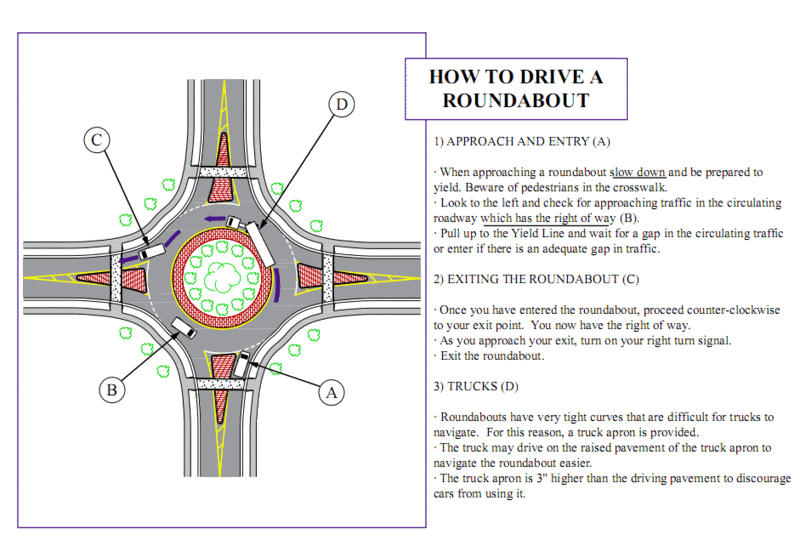
Two-lane:
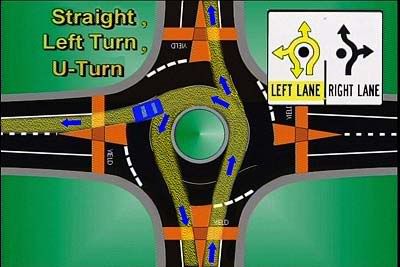
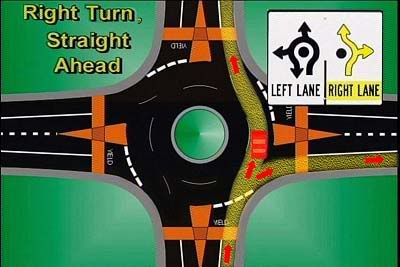
Modern roundabouts are intersection improvements that move traffic without the aid of traffic signals and improve roadway congestion. Roundabouts have the following advantages:
Improved safety due to reduced vehicle speeds
The following questions will be answered which will assist you in safely negotiating a modern two-lane roundabout:
The Yield Principle:
All vehicles approaching the roundabout must yield to traffic inside the circulating lanes as well as exiting vehicles. Approaching drivers should look to their left to determine if they have an adequate gap in traffic in which to enter the roundabout.
Choose Your Lane:
Lane choice at a two-lane roundabout is similar to a standard intersection. When approaching, choose either the right or left lane that corresponds to your desired movement. Lane choice is based on the driver’s destination. The left lane allows left turns, straight ahead movements and U-turns only. Right lane maneuvers include immediate right turns or straight ahead movements.
Never change lanes once you have entered the circulating lanes. If you approach the roundabout in the left lane, enter the inside circulating lane and maintain that lane position until you exit. Approaching the roundabout in the right lane requires that you enter the outside circulating lane.
Slow Down:
Everyone must obey the "rules of the road":
Large Vehicles:
Drivers should be aware that large trucks may straddle both circulating lanes. Therefore, never drive adjacent to or pass large trucks while maneuvering through a roundabout. If you follow a truck into a roundabout, do not attempt to pass.
Emergency Vehicles:
Always give emergency vehicles the right-of-way when they approach. If you have not yet entered the roundabout, pull over to the right allowing emergency vehicles to pass. Never stop inside the roundabout. Continue to your exit and then pull over to the right lane allowing the emergency vehicles to maneuver around you.
Pedestrians:
Before entering the crosswalk, pedestrians should always look in the direction of oncoming traffic. Find a gap in traffic and then cross. Roundabouts have a refuge island providing a safe area between opposing travel lanes. Be aware of traffic entering and exiting the roundabout.
Bicyclists:
Bicyclists should use the crosswalks like a pedestrian and walk their bikes across. Only experienced bicyclists should ride through the roundabout. If riding a bike through the roundabout, the same "rules of the road" apply for a bike as an automobile.
Summary and Conclusion:
Respecting the right-of-way of others is not limited to situations such as yielding to pedestrians in crosswalks, or watching carefully to ensure the right-of-way of bicyclists and motorcyclists. Motorists must respect the right-of-way of others, by not violating traffic laws such as failing to top at a stop sign or traffic light, speeding, making unsafe lane changes, or illegal turns. Statistics show that a high percentage of injury accidents in California are caused by right-of-way violations.
A pedestrian is a person on foot or who uses a conveyance such as roller skates, skateboards, etc., other than a bicycle. A pedestrian can also be a person with a disability on a tricycle or quadricycle or in a wheelchair.
- Respect the right-of-way of pedestrians. Always stop for any pedestrian crossing at corners or other crosswalks, even if the crosswalk is in the middle of the block and at corners with or without traffic lights, whether or not the crosswalks are marked by painted lines.
- Do not pass a car from behind that has stopped at a crosswalk. A pedestrian you can’t see may be crossing.
- Do not drive on a sidewalk, except to cross it at a driveway or alley. When crossing, yield to any pedestrian.
- Do not stop in a crosswalk. You will place pedestrians in danger.
- Remember: if a pedestrian makes eye contact with you, he or she is ready to cross the street. Yield to the pedestrian.
- Allow older pedestrians more time to cross the street.
- Important: Blind pedestrians rely on the sound of your vehicle to remain aware of their surroundings, so it is important that you stop your vehicle within 5 feet of the crosswalk. Drivers of hybrid or electric vehicles need to remain especially aware that the lack of engine noise may lead a blind pedestrian to assume there is not a car nearby. Follow this cue: When a blind person pulls in his/ her cane and steps away from the intersection, this gesture usually means for you to go.
Pedestrians have the right-of-way in crosswalks, even if the crosswalk is in the middle of the block.
A crosswalk is that part of the roadway where the sidewalk lines would extend across the street, and it is set aside for pedestrian traffic.
Crosswalks are often marked with white lines. Yellow crosswalk lines may be painted at school crossings. Most often, crosswalks in residential areas are not marked.
An intersection is any place where one line of traffic meets another. Intersections include cross streets, side streets, alleys, freeway entrances, and any other location where vehicles traveling on different highways or roads join each other.
- At intersections without STOP or YIELD signs, slow down and be ready to stop. Yield to vehicles already in the intersection or just entering it. Also, yield to the car which arrives first, or to the car on your right, if it reaches the intersection at the same time as you do.
- At “T” intersections without STOP or YIELD signs, yield to vehicles on the through road. They have the right-of-way.
- When you turn left, give the right-of-way to all vehicles approaching you that are close enough to be dangerous. Also, look for motorcyclists, bicyclists, and pedestrians. On divided highways, or highways with several lanes, watch for vehicles coming in any lane you must cross. Turn left only when it is safe.
- When there are STOP signs at all corners, stop first, then follow the above rules.
- Yield to traffic before entering the road again if you have parked off the road or are leaving a parking lot, etc.
Safety suggestion:
While waiting to turn left, keep your wheels pointed straight ahead until it is safe to start your turn. If your wheels are pointed to the left, and a vehicle hits you from behind, you could be pushed into oncoming traffic.


A roundabout is an intersection where traffic travels around a central island in a counter-clockwise direction. Vehicles entering or exiting the roundabout must yield to vehicles, bicyclists, and pedestrians.
As you approach the entry to the roundabout, there will be a "Yield" sign and dashed yield line at the roundabout intersection. Slow down, watch for pedestrians and bicyclists and be prepared to stop if necessary. When you enter, yield to circulating traffic from the left, but do not stop if it is clear. The roundabout will have "One Way" and Chevron signs mounted in the center island. Upon passing the street prior to your exit, turn on your right turn signal and watch for pedestrians and bicyclists as you exit. Left turns are completed by traveling around the center island.

Two-lane:
- Vehicles in the circulating lanes have the right-of-way.
- Vehicles approaching the roundabout are required to yield to vehicles in the circulating lanes.
- All vehicles are required to yield to pedestrians in the crosswalks.
- Traffic movement in the roundabout is always counterclockwise.
- If you are in the inside lane, you should enter the inside circulating lane and exit into the inside lane.
- If you are in the outside lane, you should enter the outside circulating lane and exit into the outside lane.
- Drivers should be aware of traffic in the neighboring lane.
- Never change lanes once you enter into the circulating lanes.
- Speed should be 20 mph or less as posted.


Modern roundabouts are intersection improvements that move traffic without the aid of traffic signals and improve roadway congestion. Roundabouts have the following advantages:
Improved safety due to reduced vehicle speeds
- Reduced vehicle emissions
- Increased roadway capacity
- Improved traffic circulation
The following questions will be answered which will assist you in safely negotiating a modern two-lane roundabout:
The Yield Principle:
All vehicles approaching the roundabout must yield to traffic inside the circulating lanes as well as exiting vehicles. Approaching drivers should look to their left to determine if they have an adequate gap in traffic in which to enter the roundabout.
Choose Your Lane:
Lane choice at a two-lane roundabout is similar to a standard intersection. When approaching, choose either the right or left lane that corresponds to your desired movement. Lane choice is based on the driver’s destination. The left lane allows left turns, straight ahead movements and U-turns only. Right lane maneuvers include immediate right turns or straight ahead movements.
Never change lanes once you have entered the circulating lanes. If you approach the roundabout in the left lane, enter the inside circulating lane and maintain that lane position until you exit. Approaching the roundabout in the right lane requires that you enter the outside circulating lane.
Slow Down:
Everyone must obey the "rules of the road":
- Vehicle speeds should be less than 20 mph.
- Yield to vehicles already in the circulating lanes.
- Do not enter in front of a circulating vehicle unless you have space to do so safely.
- Do not make left turns from the right lane.
- Never change lanes inside the roundabout.
- U-turns are only allowed from the left lane.
Large Vehicles:
Drivers should be aware that large trucks may straddle both circulating lanes. Therefore, never drive adjacent to or pass large trucks while maneuvering through a roundabout. If you follow a truck into a roundabout, do not attempt to pass.
Emergency Vehicles:
Always give emergency vehicles the right-of-way when they approach. If you have not yet entered the roundabout, pull over to the right allowing emergency vehicles to pass. Never stop inside the roundabout. Continue to your exit and then pull over to the right lane allowing the emergency vehicles to maneuver around you.
Pedestrians:
Before entering the crosswalk, pedestrians should always look in the direction of oncoming traffic. Find a gap in traffic and then cross. Roundabouts have a refuge island providing a safe area between opposing travel lanes. Be aware of traffic entering and exiting the roundabout.
Bicyclists:
Bicyclists should use the crosswalks like a pedestrian and walk their bikes across. Only experienced bicyclists should ride through the roundabout. If riding a bike through the roundabout, the same "rules of the road" apply for a bike as an automobile.
Summary and Conclusion:
- Yield to all traffic circulating the roundabout before entering.
- Make the appropriate lane choice based on your desired destination before entering the roundabout.
- After entering the roundabout, never change lanes or pass other vehicles.
- Slow down to safely enter and negotiate the roundabout.
- Never pass or drive adjacent to a truck in a roundabout.
- Do not impede emergency vehicles.
- Pedestrians should utilize the refuge islands in order to safely cross both directions of travel.
- Only experience bicyclists should drive through the roundabout